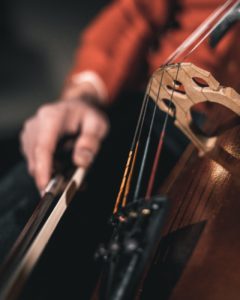
The most typical frustration that an aspiring student of improvisation expresses to me in our initial consultation is that they feel stuck. They feel rather stagnant, uninspired by their own predictable (to them, anyhow!) playing.
And as I listen to them play and ask questions, I notice without fail that not enough of their practice study and effort is put into studying rhythm and meter.
Lots of work done on melodic sequences, harmonic substitution, licks, etc., but not much consciousness about how to most easily vary the patterns they already know all too well.
There are many ways to begin to vary what you do rhythmically and metricallyin order to increase your improvisational vocabulary. I’d like to offer here one very simple, very easy thing you can do with the patterns (scales, arpeggios, licks) that can open up your ears and thinking in a fundamental way.
Here it is: Rythmically displace every pattern that you practice.
Simple as that.
If it’s an eighth-note based pattern that starts on the downbeat of beat one, start it on the upbeat (the “and”) of beat one. (You can also start it on the upbeat of the fourth beat, as well.)
If it’s a sixteenth-note based pattern that starts on the downbeat of beat one, start it after a sixteenth rest (the “e”) of beat one. (Or on the “a” of the preceding fourth beat.)
Take a look at the bebop cliché I put at the top of this page, and play through it, if you have your instrument handy.
Now take a look at the pattern below. It’s the same pattern as above delayed by an eighth rest:

If you play through this pattern (especially if you use a swing feel) you’ll hear that the pattern sounds fundamentally different. Because of the contour of line, and where the harmonic tensions are placed, the overall quality and color of the pattern is transformed.
This is such an easy thing to do whenever you practice patterns, and should be done with every pattern you practice. If you make this a habit of your daily practice routine, you’ll benefit in several ways:
First, you’ll breathe new life into all the patterns that you already know and use to create your improvisations.
Second, you’ll change your habits of phrasing, opening up yourself to new ways to feel the bar-form and express yourself within this form.
Third, you’ll improve your time.
Fourth, you’ll increase your rhythmic and metric imagination. (Displacing patterns that fit neatly into the “4/4 box” gets you to immediately feel and imagine other meters imposed upon 4/4.
Fifth, you’ll improve your ears, as you learn to hear tensions in “unusual” places (sometime going over the measure from dominant to tonic).
These things will most certainly help you grow and improve as an improviser.
But there is another, very important benefit of practicing things this way. By regularly displacing the beat in the melodic patterns you practice, you invite your brain to find new ways to organize the motor activity necessary to play the pattern.
This is a HUGE benefit for you, whether you improvise or not. It is the “novelty” of the rhythmic displacement that calls upon your brain to virtually “recreate” the pattern. Doing this regularly helps you to better retain any new material that you learn.
It helps you develop a kind “neuro-flexibility” that you’ll take into the practice room as well into performance. (From a neuroscientific point of view, we are wired more for “flexibility” than we are “consistency”, where motor skill is concerned.)
One of the things I most admire (and there are many things to admire!) about saxophonist and jazz pedagogy teacher, Matt Otto, are his free video lessons. With practically every pattern he presents for you to study, he demonstrates the pattern played with an eighth-note displacement. (He encourages you to do so, too!)
So make this simple variation available and habitual to your practice sessions. You’ll be surprised at how quickly you begin to change how you hear yourself and express yourself as you improvise.
If you’re interested in studying rhythmic displacement in a more comprehensive, methodical way, please consider my e-book, Essential Polymeter Studies in 4/4 Time for the Improvising Musician. Thanks!
